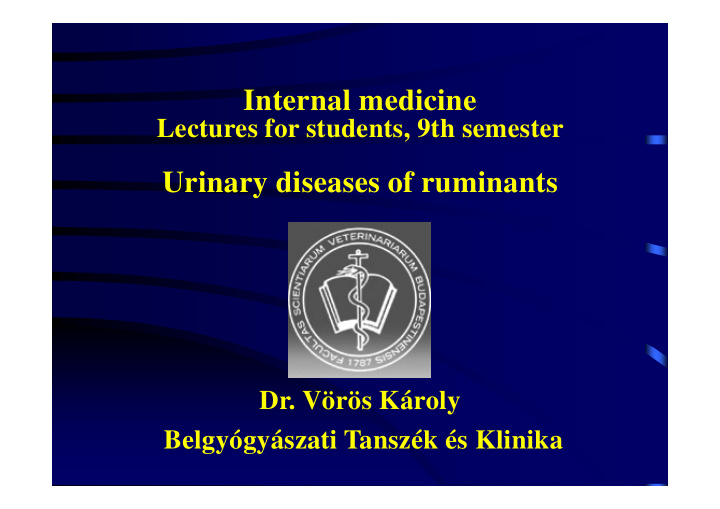



Internal medicine Lectures for students, 9th semester Urinary diseases of ruminants Dr. Vörös Károly Belgyógyászati Tanszék és Klinika
Structure of the lectures Renal diseases A) Non-purulent renal diseases I. • Acute nephrosis • Renal amyloidosis B) Purulent renal diseases I. • Non-purulent nephritis • Contagious bovine pyelonephritis Urolithiasis
Non-purulent renal diseases I. Common characteristics: • Subclinical course, usually not diagnosed in vivo • Symptoms of underlying disease are dominant (common) • Clinical signs of renal disease (rare) Acute nephrosis Cause: intoxication, Pb/As/Cu toxicosis, hemoglobin nephrosis, monensin, tannins (foliage of oak trees and acorns) unidenfied toxin of Amaranthus retroflexus, ochratoxin Characteristics: • Rarely diagnosed clinically (no obvious signs) • Urine: proteinuria, renal epithelial cells/cylinders (casts)
Non-purulent renal diseases II. Renal amyloidosis Cause: Chronic inflammatory (purulent) diseases of other organs immunological processes abnormal antigen- antibody reaction hyperglobulinemia amyloid protein deposition (systemic disease) Sequela: Renal enlargement, weight loss Nephrotic syndrome: massive proteinuria + edema formation Uremia: halitosis, uremic stomatitis, diarrhoea Differential diagnosis: perform rectal examination, urinalysis ! traumatic pericarditis, paratuberculosis
Renal amyloidosis in a bull ( Blowey and Weaver, 1991)
Non-purulent renal diseases III. Non-purulent nephritis (= glomerulonephritis, interstitial nephritis) • primary disease or component of systemic diseases • immun-complex formation (glomerulonephritis) • infectious diseases (interstitial nephritis, e.g. leptospirosis) Characteristics: • Rarely diagnosed clinically (no obvious signs) • Can be detected by ultrasound-guided biopsy if necessary • Urine: proteinuria, renal epithelial cells/cylinders (casts)
Purulent renal diseases I. Purulent nephritis (embolic nephritis) (embolic suppurative nephritis or renal abscess ) Occurrence and etiology: bacterial ( metastatic emboli ), hematogenous route from • valvular endocarditis • suppurative lesions in uterus, udder, navel (umbilicus) • septicemias in calves/ lambs Characteristics: • rarely diagnosed clinically (no obvious signs) • but: +/- rectal finding, • urine: proteinuria, pyuria, (microsc.) hematuria, bacteruria Treatment: antibiotics (sensitivity test; no nephrotoxic drugs)
Purulent renal diseases II. Contagious bovine pyelonephritis 1. Occurrence and etiology milking cows of 4-8 years, after calving, (atfter repeated antibiotics!), especially in autumn/winter Corynebacterium renale (C. bovis renalis), serotypes I. and III. • urease pos. NH 3 production tissue necrosis • attaches to the epithelium • resistant to phagocytosis (+ Arcanobacterium/Corynebacterium pyogenes, E. coli) usually ascending and rarely hematogenous route Cystitis, urethritis, pyelitis → nephritis (usullay bilateral)
Bovine contagious pyelonephritis Necropsy findings
Purulent renal diseases III. Contagious bovine pyelonephritis 2. Clinical signs: subacute course, decreased milk production after calving; fluctuating fever, anorexia, dullness, weight loss, signs of renal pain: kyphosis, stranguria + colic rectal examination : painful, enlarged ( left ) kidney with abnormal consistency and irregular surface ( +/- enlarged ureter) ultrasound examination kidneys, bladder endoscopy Laboratory examination : Blood : anemia, neutrophilia, uremia Urine : macroscopic abnormalities: smell, color, debris, pus, mucus detection of free NH 3 with HCl (hydrochlorid acid) pH: 8.0-9.0; detection of protein, blood, neutrophils (Donne-test) Detection of C. renale: microscope, IF method, culture
Bovine contagious pyelonephritis Glass stick probe with HCL: detection of free NH 3 NH 3 + HCL = NH 3 Cl „smoke” Abnormal urine
Purulent renal diseases IV. Contagious bovine pyelonephritis 3. Diagnosis: history, clinical signs, urinalysis, (ultrasonography) differentiate from RPT, other urinary diseases Treatment: indication of treatment (?), early diagnosis ! • antibiotics (resistance test): penicillin (+ streptomycin?) • acidification 10-14 (21) days (sodium phosphate, 100 g/24h) • nephrectomy (?!) Prevention: - good hygiene at calving, - avoid catheterization and breeding with a bull Prognosis: early phase: favourable later phase: questionable - poor
Urolithiasis in ruminants I. Occurrence feedlot bulls: in vivo 0 -10%, post mortem can be 75 - 80% feedlot lambs: in vivo 12 - 15%, post mortem can be 85 - 100%, onset: mainly between October – March Uroliths: magnesium-ammonium-phosphate (struvit) = most common + Ca phosphate, Mg carbonate, Ca carbonate, silica, Ca oxalate stone formation: kidney (bladder) accumulation within the bladder urethral obstruction
Urolithiasis in ruminants II. Pathogenesis: • (++) grain, i.e. minerals, (- -) water → (++) saturated urine • effect of pH (crystal formation, stability of protective colloids) • nidus formation: inflammation (adenovirus, bacteria) vitamin A deficiency ?) estrogens (synchronization, clover) precipitation of solutes sand, stone formation Consequences: hydronephrosis, pyelitis?, cystitis? urethral obstruction, bladder rupture
Urolithiasis in ruminants III. Clinical signs: • Maybe silent or can occur with abdominal pain • Signs of cystitis ( several animals affected ) • Signs of urethral obstruction: sudden colic, dysuria, stranguria, hematuria, cristals on preputium, sign of urethral dilatation in bulls at the perineum • Rupture of the urethra: infiltration with urine: abdomen, perineum Uremia death • Rupture of the bladder: uroperitoneum uremia, +-/ undulation, abdominocentesis
Urolithiasis in bulls
Urolithiasis in a male calf Marked abdominal distension and infiltration of the preputium and ventral abdomen („water belly)
Urolithiasis in sheep Signs of urethral obstruction 1.
Urolithiasis in sheep Signs of urethral obstruction 2.
Urolithiasis in ruminants IV. Diagnosis: clinical signs, catheterization?, bladder ultrasonography Treatment: - obstruction → surgery or slaughter for salvage (spasmolytics might be tried in partial obstruction) - to dissolve struvit (?!): NH 4 Cl (10 g/sheep) per os Prevention: • change the feeding ( decrease of P, Mg ) after stone analysis • struvit: feeding NH 4 Cl (45 g/steer and 10 g/sheep) • decrease nidus formation and provide enough water (e.g. vaccination against adenovirus in sheep herds ) • Provide vitamin A supplementation
Literature Blowey, R.W.; Weaver, A.D.: A colour atlas of diseases and disorder of cattle. Wolfe Publishing Ltd, Aylesbury, 1991. +
Recommend
More recommend